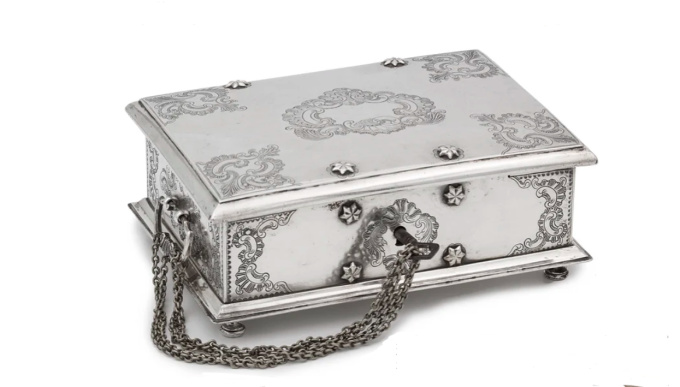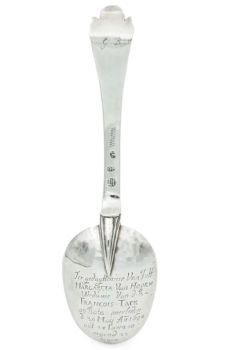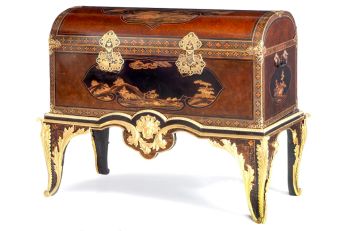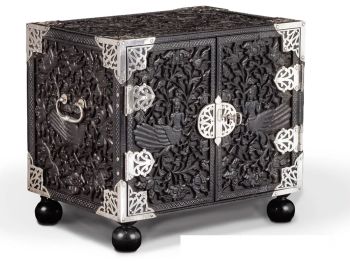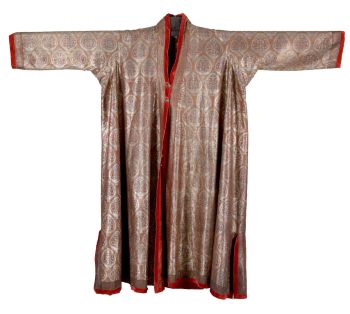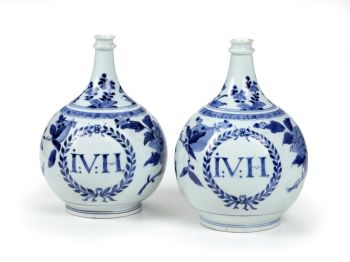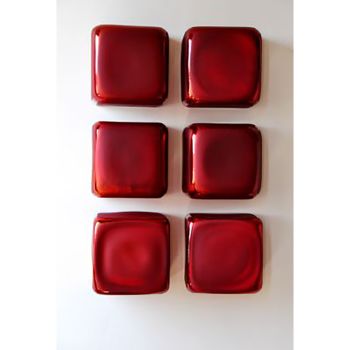A fine Indonesian silver Rococo engraved sirih box 1770
Artiste Inconnu
Argent
7 ⨯ 18 ⨯ 13 cm
Prix sur demande
Zebregs & Röell - Fine Art - Antiques
- Sur l'oeuvre d'artBatavia (Jakarta), circa 1770, with maker’s mark HR, Hendrik Rennebaum (?- 1793, act. 1769-1780) and a tree, probably the crest of Hendrik Rennebaum
H. 7 x W. 18.4 x D. 13 cm
Weight: 1115 grams
With a silvered metal betel nut cutter in the shape of a parrot, 19th century, measuring 17.5 cm in length.
Thanks to the inventory of his possessions made in 1780, we know that Hendrik Rennebaum had a thriving business. The reason for the inventory was that Rennebaum had become mentally incompetent to manage his own affairs. The contents of his shop included over 450 objects made of gold and silver, ranging from jewellery, silver tableware, commemorative salvers, tobacco boxes and betel boxes. Unfortunately, of the 20 commemorative salvers mentioned, only one so far is known to survive, and of the 20 cuspidors and 23 silver candlesticks, not one has yet been traced. The same is true of other domestic objects, such as mustard pots, fish dishes, finger bowls, salt cellars and tobacco braziers. Of the large quantity of silver tableware, only a single porridge spoon survives. The small items include pin trays, purse frames and silver toys, as well as knob, handles for walking sticks, buttons, and shoe and knee buckles.
The inventory also includes all of Rennebaum’s tools, and, as was customary at that time, also his enslaved people. Three of them were silversmiths: ‘January van Bengalen', who had a wife and two children, ‘October van Boegis’ who was a ‘boss silversmith’ and ‘Julij van Soembawa’.
From 1775 to 1780 Rennebaum held the post of assay master, and
was very active in public life, being the standard-bearer for the Westzijdse Burgercompagnie from 1769 to 1771, and dean and elder of the Lutheran Church in Batavia. - Sur l'artiste
Il peut arriver qu'un artiste ou un créateur soit inconnu.
Certaines œuvres ne doivent pas être déterminées par qui elles sont faites ou elles sont faites par (un groupe d') artisans. Les exemples sont des statues de l'Antiquité, des meubles, des miroirs ou des signatures qui ne sont pas claires ou lisibles, mais aussi certaines œuvres ne sont pas signées du tout.
Vous pouvez également trouver la description suivante :
•"Attribué à …." A leur avis probablement une oeuvre de l'artiste, au moins en partie
•« Atelier de …. ou « Atelier de » À leur avis, une œuvre exécutée dans l'atelier ou l'atelier de l'artiste, éventuellement sous sa direction
•« Cercle de… ». A leur avis une oeuvre de la période de l'artiste témoignant de son influence, étroitement associée à l'artiste mais pas forcément son élève
•« Style de … ». ou "Suiveur de ...." Selon eux, une œuvre exécutée dans le style de l'artiste mais pas nécessairement par un élève ; peut être contemporain ou presque contemporain
•« Manière de… ». A leur avis une oeuvre dans le style de l'artiste mais d'une date plus tardive
•"Après …." A leur avis une copie (quelle qu'en soit la date) d'une oeuvre de l'artiste
•« Signé… », « Daté… ». ou « Inscrit » À leur avis, l'œuvre a été signée/datée/inscrite par l'artiste. L'ajout d'un point d'interrogation indique un élément de doute
• "Avec signature ….", "Avec date ….", "Avec inscription …." ou "Porte signature/date/inscription" à leur avis la signature/date/inscription a été ajoutée par quelqu'un d'autre que l'artiste
Êtes-vous intéressé par l'achat de cette oeuvre?
Artwork details
Related artworks
- 1 - 4 / 12
Artiste Inconnu
A silver spoon commemorating Juff’ Margareta van Hoorn1656 - 1694
Prix sur demandeZebregs & Röell - Fine Art - Antiques
Artiste Inconnu
A Dutch colonial Indonesian betel box with gold mounts1750 - 1800
Prix sur demandeZebregs & Röell - Fine Art - Antiques
Artiste Inconnu
A Surinam-themed Amsterdam long-case clock1746 - 1756
Prix sur demandeZebregs & Röell - Fine Art - Antiques
 Sélectionné par
Sélectionné parGallerease Magazine
Artiste Inconnu
UN PLAT EN ARGENT LOBBED INDONÉSIEN INSOLITElate 17th
Prix sur demandeZebregs & Röell - Fine Art - Antiques
Artiste Inconnu
Japanese transition-style lacquer coffer 1640 - 1650
Prix sur demandeZebregs & Röell - Fine Art - Antiques
1 - 4 / 24Artiste Inconnu
A rare Japanese export lacquer medical instrument box1650 - 1700
Prix sur demandeZebregs & Röell - Fine Art - Antiques
Artiste Inconnu
A Dutch colonial Indonesian betel box with gold mounts1750 - 1800
Prix sur demandeZebregs & Röell - Fine Art - Antiques
Artiste Inconnu
Japanese transition-style lacquer coffer 1640 - 1650
Prix sur demandeZebregs & Röell - Fine Art - Antiques
Artiste Inconnu
UN MODÈLE JAPONAIS D'UN NORIMONO, UN PALANQUIN1650 - 1700
Prix sur demandeZebregs & Röell - Fine Art - Antiques
Artiste Inconnu
Japanese transition-style lacquer coffer 1640 - 1650
Prix sur demandeZebregs & Röell - Fine Art - Antiques
1 - 4 / 24Artiste Inconnu
Japanese transition-style lacquer coffer 1640 - 1650
Prix sur demandeZebregs & Röell - Fine Art - Antiques
Cornelis Anthonisz Theunissen
TRÈS RARE PREMIÈRE CARTE IMPRIMÉE D'AMSTERDAM, VILLE EN ASCENSION1544
€ 175.000Inter-Antiquariaat Mefferdt & De Jonge
 Sélectionné par
Sélectionné parDanny Bree
Artiste Inconnu
The bell of the VOC fortress in Jaffna, Sri Lanka1747
Prix sur demandeZebregs & Röell - Fine Art - Antiques
 Sélectionné par
Sélectionné parDanny Bree
Shiba Kokan
Peinture d'un hollandais fantastiqueearly 19th
Prix sur demandeZebregs & Röell - Fine Art - Antiques
Artiste Inconnu
UNE COLLECTION DE QUATRE BOÎTES À BIBLE EN IVOIRE SRI LANKAN18th century
Prix sur demandeZebregs & Röell - Fine Art - Antiques
1 - 4 / 24Artiste Inconnu
A silver spoon commemorating Juff’ Margareta van Hoorn1656 - 1694
Prix sur demandeZebregs & Röell - Fine Art - Antiques
1 - 4 / 24Artiste Inconnu
Néerlandais en miniature (Netsuke)1700 - 1900
Prix sur demandeZebregs & Röell - Fine Art - Antiques
Artiste Inconnu
The bell of the VOC fortress in Jaffna, Sri Lanka1747
Prix sur demandeZebregs & Röell - Fine Art - Antiques
 Sélectionné par
Sélectionné parDanny Bree
 Sélectionné par
Sélectionné parDanny Bree
1 - 4 / 12

